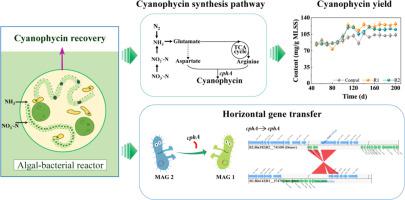当前位置:
X-MOL 学术
›
Water Res.
›
论文详情
Our official English website, www.x-mol.net, welcomes your feedback! (Note: you will need to create a separate account there.)
Toward nitrogen recovery: Co-cultivation of microalgae and bacteria enhances the production of high-value nitrogen-rich cyanophycin
Water Research ( IF 12.8 ) Pub Date : 2024-04-15 , DOI: 10.1016/j.watres.2024.121624 Hongyuan Liu , Naif Abdullah Al-Dhabi , Huiling Jiang , Bingzhi Liu , Taiping Qing , Bo Feng , Tengfei Ma , Wangwang Tang , Peng Zhang
Water Research ( IF 12.8 ) Pub Date : 2024-04-15 , DOI: 10.1016/j.watres.2024.121624 Hongyuan Liu , Naif Abdullah Al-Dhabi , Huiling Jiang , Bingzhi Liu , Taiping Qing , Bo Feng , Tengfei Ma , Wangwang Tang , Peng Zhang

|
The algal-bacterial wastewater treatment process has been proven to be highly efficient in removing nutrients and recovering nitrogen (N). However, the recovery of the valuable N-rich biopolymer, cyanophycin, remains limited. This research explored the synthesis mechanism and recovery potential of cyanophycin within two algal-bacterial symbiotic reactors. The findings reveal that the synergy between algae and bacteria enhances the removal of N and phosphorus. The crude contents of cyanophycin in the algal-bacterial consortia reached 115 and 124 mg/g of mixed liquor suspended solids (MLSS), respectively, showing an increase of 11.7 %–20.4 % ( < 0.001) compared with conventional activated sludge. Among the 170 metagenome-assembled genomes (MAGs) analyzed, 50 were capable of synthesizing cyanophycin, indicating that cyanophycin producers are common in algal-bacterial systems. The compositions of cyanophycin producers in the two algal-bacterial reactors were affected by different lighting initiation time. The study identified two intracellular synthesis pathways for cyanophycin. Approximately 36 MAGs can synthesize cyanophycin de novo using ammonium and glucose, while the remaining 14 MAGs require exogenous arginine for production. Notably, several MAGs with high abundance are capable of assimilating both nitrate and ammonium into cyanophycin, demonstrating a robust N utilization capability. This research also marks the first identification of potential horizontal gene transfer of the cyanophycin synthase encoding gene () within the wastewater microbial community. This suggests that the spread of could expand the population of cyanophycin producers. The study offers new insights into recycling the high-value N-rich biopolymer cyanophycin, contributing to the advancement of wastewater resource utilization.
中文翻译:

氮回收:微藻和细菌共培养提高高价值富氮蓝藻素的产量
藻菌废水处理工艺已被证明在去除营养物和回收氮 (N) 方面非常有效。然而,有价值的富氮生物聚合物蓝藻素的回收仍然有限。本研究探讨了两个藻菌共生反应器内蓝藻素的合成机制和回收潜力。研究结果表明,藻类和细菌之间的协同作用增强了氮和磷的去除。藻菌联合体中蓝藻素的粗含量分别达到115和124mg/g混合液悬浮固体(MLSS),与传统活性污泥相比增加了11.7%~20.4%(<0.001)。在分析的 170 个宏基因组组装基因组 (MAG) 中,有 50 个能够合成蓝藻素,表明蓝藻素生产者在藻类-细菌系统中很常见。两个藻菌反应器中蓝藻素生产者的组成受到不同光照启动时间的影响。该研究确定了蓝藻素的两种细胞内合成途径。大约 36 个 MAG 可以使用铵和葡萄糖从头合成蓝藻素,而其余 14 个 MAG 需要外源精氨酸才能生产。值得注意的是,几种高丰度的 MAG 能够将硝酸盐和铵同化为蓝藻素,表现出强大的氮利用能力。这项研究还标志着首次鉴定出废水微生物群落内蓝藻素合酶编码基因()的潜在水平基因转移。这表明蓝藻素的传播可能会扩大蓝藻素生产者的数量。该研究为高价值富氮生物聚合物蓝藻素的回收利用提供了新的见解,有助于废水资源化利用的进步。
更新日期:2024-04-15
中文翻译:

氮回收:微藻和细菌共培养提高高价值富氮蓝藻素的产量
藻菌废水处理工艺已被证明在去除营养物和回收氮 (N) 方面非常有效。然而,有价值的富氮生物聚合物蓝藻素的回收仍然有限。本研究探讨了两个藻菌共生反应器内蓝藻素的合成机制和回收潜力。研究结果表明,藻类和细菌之间的协同作用增强了氮和磷的去除。藻菌联合体中蓝藻素的粗含量分别达到115和124mg/g混合液悬浮固体(MLSS),与传统活性污泥相比增加了11.7%~20.4%(<0.001)。在分析的 170 个宏基因组组装基因组 (MAG) 中,有 50 个能够合成蓝藻素,表明蓝藻素生产者在藻类-细菌系统中很常见。两个藻菌反应器中蓝藻素生产者的组成受到不同光照启动时间的影响。该研究确定了蓝藻素的两种细胞内合成途径。大约 36 个 MAG 可以使用铵和葡萄糖从头合成蓝藻素,而其余 14 个 MAG 需要外源精氨酸才能生产。值得注意的是,几种高丰度的 MAG 能够将硝酸盐和铵同化为蓝藻素,表现出强大的氮利用能力。这项研究还标志着首次鉴定出废水微生物群落内蓝藻素合酶编码基因()的潜在水平基因转移。这表明蓝藻素的传播可能会扩大蓝藻素生产者的数量。该研究为高价值富氮生物聚合物蓝藻素的回收利用提供了新的见解,有助于废水资源化利用的进步。



























 京公网安备 11010802027423号
京公网安备 11010802027423号